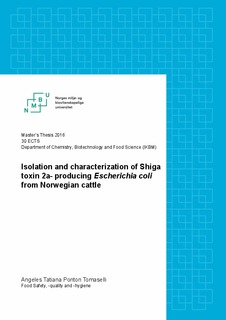| dc.contributor.advisor | Holo, Helge | |
| dc.contributor.advisor | Sekse, Camilla | |
| dc.contributor.author | Pontón Tomaselli, Angeles Tatiana | |
| dc.date.accessioned | 2016-08-10T13:04:21Z | |
| dc.date.available | 2016-08-10T13:04:21Z | |
| dc.date.issued | 2016-08-10 | |
| dc.identifier.uri | http://hdl.handle.net/11250/2398694 | |
| dc.description.abstract | Shiga toxin-producing Escherichia coli, STEC, also called Verocytotoxin-producing E. coli (VTEC) is a pathogroup that include all E. coli harboring Shiga toxin genes (stx). STEC have emerged as a group of foodborne pathogens that cause disease of varying severity in humans. Particularly, the association of STEC with potential fatal disease outcomes such as Hemorrhagic colitis (HC) and haemolytic uremic syndrome (HUS) represents a public health concern. Cattle are recognized as the main reservoir of STEC, and bovine fecal contamination as the vehicle of transmission. Yet, not all STEC are human pathogens. Some virulence factors such as Shiga toxin subtype 2a (stx2a) and the adhesin intimin (encoded by the eae- gene) have been more often associated with severe human disease.
In this study, fecal samples from 178 Norwegian cattle herds were examined for the presence of stx genes in general and the HUS-associated subtype stx2a in particular. stx2a-positive (stx2a+) STEC were further isolated and characterized to determine the potential pathogenicity of the isolates. The results indicated a surprisingly high prevalence of stx2a- genes (16.9%) in fecal samples. A broad distribution of stx was also observed with a total of 96% of the herds positive for one or both of the stx variants (stx1/stx2). This is the first study on prevalence of stx genes in Norwegian cattle. A total of 86 Stx2a+ isolates were recovered from 50% of the PCR -positive fecal samples and 25 isolates were further characterized.
The 25 selected stx2a+STEC belonged to two phylogenetic groups with 52% in the A-group and 48% in the B1-group. Within phylogroup A, the isolates presented very similar virulence profiles, while more diverse profiles were distributed among phylogroup B1. Two isolates were O26 and two O113, both serogroups associated with severe disease. The rest of the isolates did not belong to any of the serogroups tested. The most distributed virulence gene among the isolates, additional to the selected virulence marker stx2a, was ehxA. Intimin encoding eae was also present in some isolates. Comparison of virulence profiles indicates both similarities and differences between the strains isolated from human patients and from cattle. However, based on their virulence profiles, the potential pathogenicity of these strains cannot be discarded. Further analysis of the whole genome sequences can contribute to insight into the real pathogenicity of stx2a+ STEC from cattle. | nb_NO |
| dc.language.iso | eng | nb_NO |
| dc.publisher | Norwegian University of Life Sciences, Ås | |
| dc.subject | Food Microbiologi | nb_NO |
| dc.subject | Food Safety | nb_NO |
| dc.subject | Escherichia Coli | nb_NO |
| dc.subject | Shiga toxin-producing E. coli | nb_NO |
| dc.title | Isolation and characterization of Shiga toxin 2a-producing Escherichia coli from Norwegian cattle | nb_NO |
| dc.type | Master thesis | nb_NO |
| dc.subject.nsi | VDP::Technology: 500 | nb_NO |
| dc.subject.nsi | VDP::Mathematics and natural science: 400 | nb_NO |
| dc.source.pagenumber | 57 | nb_NO |
| dc.relation.project | Founded by Research Council of Norway (NFR 221663) and the Norwegian Food Authority | nb_NO |
| dc.description.localcode | M-MAT | nb_NO |
